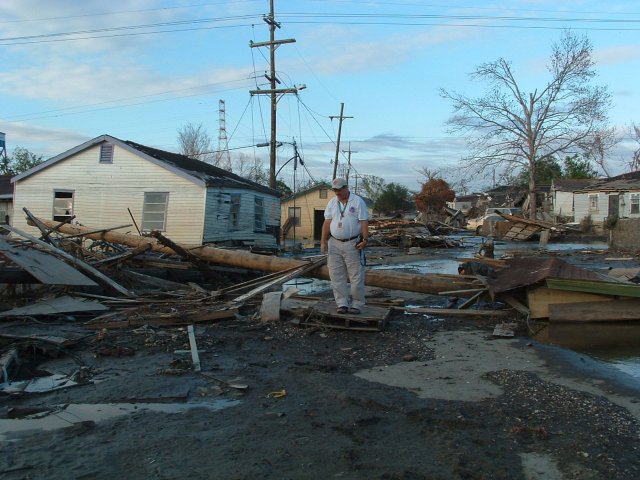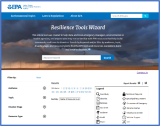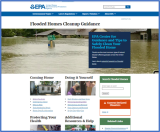Communities, Resilience & Remediation

EPA researchers are investigating the intertwined social and environmental variables that affect community resilience and vulnerability to chemical, biological, radiological, and nuclear (CBRN) incidents and other disasters.
The researchers use human-centered design to develop decision-support tools and resources for regional, state, tribal, and local partners to use in building relationships and trust, community engagement and empowerment, and building resilience in an equitable way. Results from this research can be used in emergency response, remediation, and resilience work.
Resilience A capability to anticipate, prepare for, respond to, and recover from significant multi-hazard threats with minimum damage to social well-being, the economy, and the environment. is the ability to prepare for, withstand, and successfully recover from a disaster. Communities are very complex, and no disaster is the same. Remediation Cleanup or other methods used to remove or contain a toxic spill or hazardous materials from a hazardous waste site. actions, otherwise known as “cleanup,” at contaminated sites takes place in diverse socio-cultural contexts. It involves working with communities that have different ethnic identities, languages, histories, values, and ideologies.
Research Reports
How to Get to Know Communities and Cultures Methodology Report
Audience: Superfund, brownfield, emergency response, and removal managers, and community involvement coordinators from EPA and state environmental agencies.
This report helps remediation and removal managers learn more about the communities and affected populations near contaminated sites. It contains steps and resources for identifying relevant cultural characteristics, getting to know local residents and leaders, and generating cross-cultural understanding. The report helps EPA and state agencies carry out culturally informed cleanups.
Building Trust and Relationships in Cleanup Community Engagement, from Theory to Practice Report
Audience: Superfund, brownfield, emergency response, and removal managers; community involvement coordinators from EPA and other Federal and state environmental agencies; applied social scientists.
This report helps practitioners involved in contaminated site cleanups effectively integrate evidence-based community engagement practices into cleanup efforts. It shares insights gathered from research with EPA personnel on practices for community engagement that enable remediation and removal projects address environmental justice, empowerment, and equity as part of cleanup work.
Audience: Federal, state, local, tribal, and territorial waste managers and emergency managers involved with debris removal planning and implementation.
Managing waste and debris after a disaster is necessary for community recovery and resilience. It begins at the local level, but at a time when residents, government offices, and infrastructure systems are overwhelmed. This report analyzes ways that government agencies at all levels can support community capacity for disaster waste and debris management. It discusses how four dimensions of community capacity affect post-incident debris removal: interorganizational networks; knowledge, skills, and learning; leadership and administrative capacity; and values and norms.
Available Tools
Environmental Resilience Tools Wizard

Audience: Federal, state, local, territorial, and tribal emergency management and environmental agencies.
This online wizard helps state, tribal, and local emergency managers and environmental agencies find EPA tools and resources that can help them build resilience. These resources address environmental concerns that may arise during an incident. They can be used during disaster preparedness, response, and recovery. The wizard allows searches by keywords, filters, or both to find resilience-related tools and resources on air quality, water quality, environmental justice, ecosystems, sustainability, and waste.
Audience: State, tribal, territorial, county, and municipal agencies in environment, public health, emergency management, public works, or land use. Community-based organizations for climate, environmental, or social justice.
This downloadable application supports communities in strengthening resilience to disasters and climate change. It guides a team of users through a process to engage community members in resilience planning to generate solutions that advance equity. The tool has five sections that contain activities for listening to local voices in resilience planning. Users can select activities that best meet their needs and use them to plan collaborative workshops to assess hazards, vulnerability, and resilience. This helps identify actions that can strengthen community resilience in ways that address the needs of those made vulnerable by social and environmental inequalities.

Audience: Homeowners, renters, and disaster volunteers.
This website contains short, how-to videos on how to safely re-enter a flood home, remove contaminated materials, clean it out, and begin repairs. Flooded homes can contain degraded indoor air quality and other health hazards (lead, asbestos, mold, bacteria). The research team used human-centered design and disaster anthropology research to develop risk communication based on detailed technical guidance for remediating flooded homes. The website helps homeowners, renters, and volunteers take action to safely clean out and fix up homes after a flood.
Featured Science Matters Stories
EPA Researchers Enhance Community Resilience
Additional Research Products
See more community resilience research products in Science Inventory
